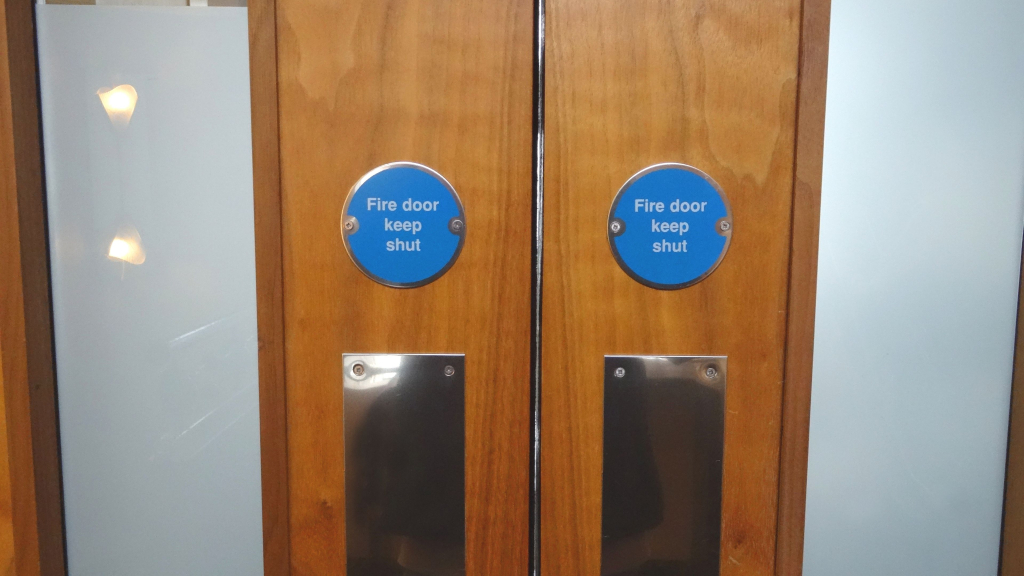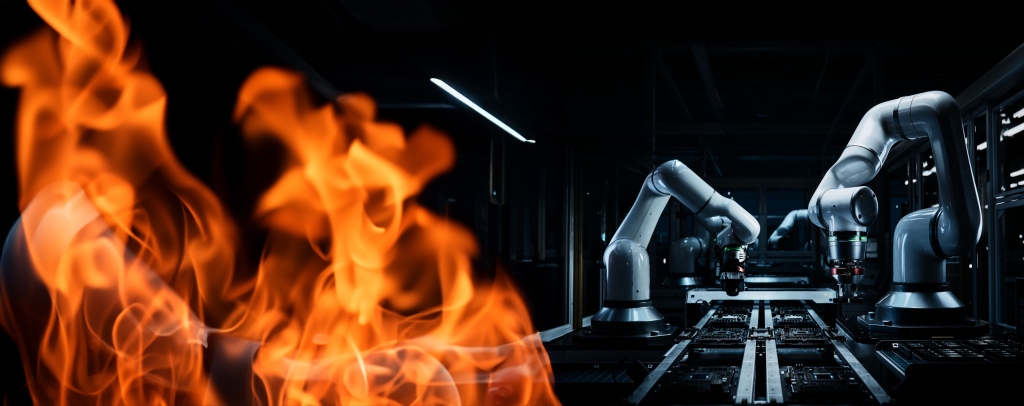Whats the best type of activation for my speed door?
0 min read
How your speed door operates will largely depend on your location, and the kind of business you run. From the traditional push button or pull cord, to the advanced sensor-based operation, there are lots of speed door activation options available to you. In this white paper, we’ll run through the pros and cons for each, helping you to decide which is the best type of activation switch for your speed door.
MANUAL SPEED DOOR ACTIVATION SWITCHES
PUSHBUTTON
How does it work? The standard operation for a high speed door, a push button works via a three-button control panel with options for up, down and stop. It also comes with a mushroom push button on the other side of the opening.
Why choose it?
- Cost-effective.
- Reliable and easily replaceable or upgradeable in the future.
- Compatible with wide-range of traffic.
Things to consider:
- It introduces a common touch point for traffic increasing the likelihood of contamination.
- It’s not suitable for vehicle traffic as drivers need to dismount to open the door.
- Because it can be used by anyone, it could pose a potential risk to pedestrians who could access and use the button without permission.
PULLCORD
How does it work?
A pull cord can be operated by both vehicle or pedestrian traffic. Available with 1.5m or 2m pull cord brackets in either a galvanized or stainless steel finish. The cord itself is usually a tough nylon rope although alternative materials can be used.
Why choose it?
- Cost-effective and reliable.
- Compatible with wide-range of traffic, particularly forklifts.
Things to consider:
- It introduces a common touch point for traffic increasing the likelihood of contamination.
- The dangling cord may pose a safety and hygiene risk.
- Forklift drivers may have to lean out to pull the cord which can be a safety concern.
REMOTE CONTROL
How does it work? Remote control kits utilise a “receiver” unit connected to the door control panel and a “transmitter” (usually in the form of a hand-held “fob”) which can be used to open the door from a short distance away. The fobs can be single or multi channel to control one or more doors from the same transmitter.
Why choose it?
- Convenient method of opening the door.
- Can be used as a secondary method in conjunction with other activation such as push buttons or sensors.
- It is secure – only those with a fob can open the door, making it especially useful for external doors.
- The door can be activated from further away which might reduce the need to slow down and wait for the door to open
Things to consider:
- The fob can get misplaced or broken.
- Can be confusing or inconvenient for premises with multiple doors.
HANDS FREE SPEED DOOR ACTIVATION SWITCHES
CONTACTLESS SWITCH
How does it work?
Using non-touch microwave technology, this touch-free door activation switch is designed for installations where hygiene is important, including cleanrooms.
Why choose it?
- The contactless detection switch is fully adjustable, reducing contamination from the number of touchpoints.
- Antimicrobial for cleanroom environments.
- Water-resistant.
- Suitable for the hygienic opening of doors by pedestrian traffic.
- Easy to install, even in the case of retrofitting.
Things to consider
- Contactless technology can be less reliable and more prone to error than manual push buttons.
- It’s not suitable for vehicle traffic as drivers will need to dismount to open the door. .
CONTACTLESS SWITCH
How does it work?
Using non-touch microwave technology, this touch-free door activation switch is designed for installations where hygiene is important, including cleanrooms.
Why choose it?
- The contactless detection switch is fully adjustable, reducing contamination from the number of touchpoints.
- Antimicrobial for cleanroom environments.
- Water-resistant.
- Suitable for the hygienic opening of doors by pedestrian traffic.
- Easy to install, even in the case of retrofitting.
Things to consider
- Contactless technology can be less reliable and more prone to error than manual push buttons.
- It’s not suitable for vehicle traffic as drivers will need to dismount to open the door. .
CONTACTLESS SWITCH
How does it work?
Using non-touch microwave technology, this touch-free door activation switch is designed for installations where hygiene is important, including cleanrooms.
Why choose it?
- The contactless detection switch is fully adjustable, reducing contamination from the number of touchpoints.
- Antimicrobial for cleanroom environments.
- Water-resistant.
- Suitable for the hygienic opening of doors by pedestrian traffic.
- Easy to install, even in the case of retrofitting.
Things to consider
- Contactless technology can be less reliable and more prone to error than manual push buttons.
- It’s not suitable for vehicle traffic as drivers will need to dismount to open the door. .
CONTACTLESS SWITCH
How does it work?
Using non-touch microwave technology, this touch-free door activation switch is designed for installations where hygiene is important, including cleanrooms.
Why choose it?
- The contactless detection switch is fully adjustable, reducing contamination from the number of touchpoints.
- Antimicrobial for cleanroom environments.
- Water-resistant.
- Suitable for the hygienic opening of doors by pedestrian traffic.
- Easy to install, even in the case of retrofitting.
Things to consider
- Contactless technology can be less reliable and more prone to error than manual push buttons.
- It’s not suitable for vehicle traffic as drivers will need to dismount to open the door. .
INDUCTION LOOP
How does it work? An induction loop wire set is installed in the ground in front of the door, this creates a magnetic field to pick up vehicle traffic passing over the loop, operating the door.
Why choose it?
- Reliable with no maintenance required.
- Will pick up all vehicle traffic passing in a defined area.
- Completely weather-resistant for external openings.
- Touch-free hygienic operation.
- Picks up exclusively vehicle traffic, not pedestrians, for vehicle only doorways.
Things to consider:
- Difficult for retrofitting. Since an induction loop requires floor excavations prior to installation, it is often not possible to retrofit, particularly in hygienic areas.
- Installation cost is expensive and if the loop becomes damaged it is difficult to repair.
- Will only detect metal vehicles or components so may be unreliable for pedestrian traffic, as well as some other types of traffic.
SPOT SENSOR (TOF)
How does it work? Also known as a TOF (time-of-flight) sensor, a spot sensor works as a kind of virtual pull cord, where the traffic breaking the spot beam operates the door. It can be mounted above or beside a door depending on the traffic type and direction, and floor markers. Mounting brackets and outdoor housings can be fitted for an additional charge.
Why choose it?
- Cost-effective and reliable.
- Compatible with wide-range of vehicles, including forklifts.
- No-touch operation for improved hygiene & safety.
- Offers a greater convenience than pull cords or push buttons.
- Can be configured so as to not pick up cross-traffic.
- Suitable for pedestrians as well as forklifts.
- It is a proximity sensor as well as motion, so will hold the door open if you don’t move.
Things to consider:
- Its small field of operation means it is not suitable for all applications, especially if traffic comes from different angles of approach.
MOTION RADAR SENSOR
How does it work? A unidirectional standard radar sensor detects approaching traffic and operates the door.
Why choose it?
- Detects traffic approaching from any angle
- Sensitivity can be adjusted to filter pedestrians & cross-traffic.
- No-touch operation for improved hygiene & convenience.
- Range can be set further back for reduced waiting times.
Things to consider:
- It is not suitable for areas where there is heavy cross-traffic since the motion sensor may pick up other vehicles or pedestrians.
- Additional safety measures are required. The standard radar sensor only detects motion not presence and so will not stop the door closing on an object.
MOTION AND PRESENCE SENSOR
How does it work? An advanced microwave motion detector and an active infrared presence sensor are built in the same housing. This detects approaching traffic and operates the door, with increased precision to filter out pedestrians, cross-traffic and possible interferences. Unlike the motion sensor, the active infrared technology offers a presence area where every vehicle and object standing still close to the door will be detected.
Why choose it?
- Detects traffic approaching from any angle
- Sensitivity can be adjusted to filter pedestrians & cross-traffic.
- No-touch operation for improved hygiene & convenience.
- Range can be set further back for reduced waiting times.
Things to consider:
- It is not suitable for areas where there is heavy cross-traffic since the motion sensor may pick up other vehicles or pedestrians.
- Additional safety measures are required. The microwave sensor only detects motion not presence and so will not stop the door closing on an object.
LASER SENSOR
How does it work? More than just a sensor, the widescan laser safeguards its users and protects the door. It generates seven tilted laser curtains, creating a volumetric area in front of the door. One device can carry out three individual functions to do with the opening and closing of the door, area surveillance and safety of its users.
Why choose it?
- The laser matrix enables accurate distance measurement and calculation of object dimensions and trajectory.
- Its safety field detects approaching or parked vehicles accurately to prevent any contact with the door.
- No-touch operation for optimum hygiene and convenience.
- Improved safety. The detection area ensures accurate filtering of cross-traffic and pedestrians.
- Suitable for all conditions, even demanding environments like freezers.
- Advanced features include a virtual pull cord and partial opening.
- It can also be a form of safety device and replace a light curtain when used both sides
Things to consider:
It’s more expensive than other speed door activation sensors, and so is mainly used for
high traffic and demanding openings where the most advanced technology is required.
For more advice about the best kind of activation for your speed door, get in touch with the Tekta team today








